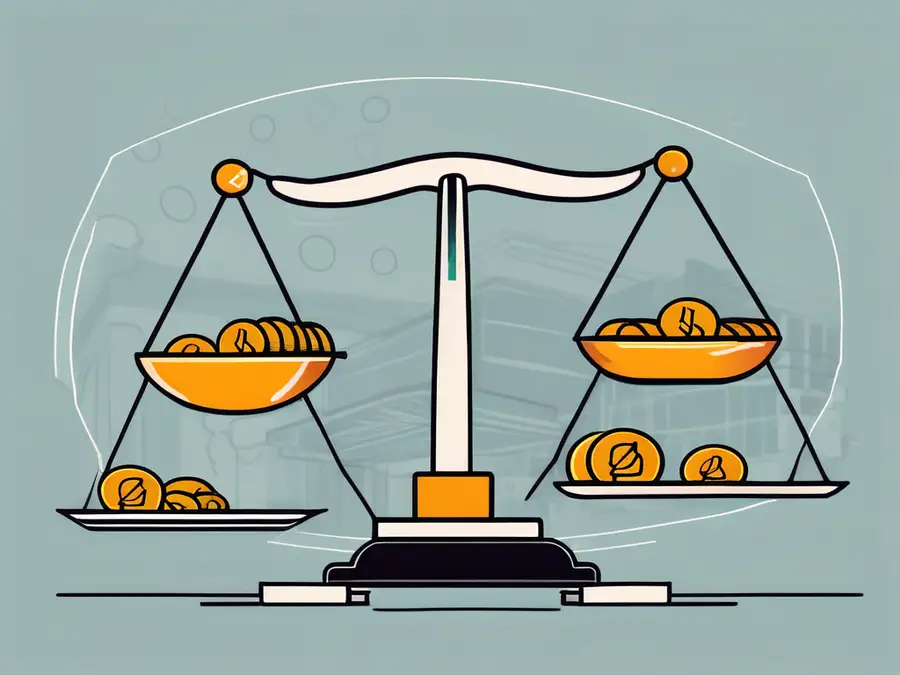The Ultimate Margin Cheat Sheet: A Comprehensive Guide to Boost Your Profits

As a business owner, you are constantly looking for ways to boost your profits. One of the most effective ways to do this is by understanding and optimizing your profit margins. In this comprehensive guide, I will provide you with all the information you need to know about profit margins, strategies to increase them, how to analyze them, the role of market conditions, and long-term sustainability. By the end of this cheat sheet, you'll have a clear roadmap to maximize your profits and take your business to the next level.
Understanding the Basics of Profit Margins
Before we dive into the nitty-gritty details, let's start by defining profit margins. In simple terms, profit margin is the percentage of revenue that remains as profit after deducting all expenses. It is a vital metric that indicates the financial health of your business and its ability to generate profits.
Profit margins are crucial because they directly impact your bottom line. By having higher margins, you can have more financial flexibility, reinvest in your business, and even explore new opportunities for growth. Without a clear understanding of profit margins, you may be leaving money on the table.
Defining Profit Margins
In its essence, profit margin is calculated by dividing your net profit by your revenue and multiplying the result by 100. This gives you a percentage that represents the proportion of profit you generate for each dollar of revenue. Different types of profit margins are commonly used, such as gross profit margin, operating profit margin, and net profit margin. Each of these focuses on specific aspects of your business's financial performance.
Importance of Profit Margins in Business
Profit margins are the lifeblood of any business. Not only do they determine your company's profitability, but they also provide valuable insights into the efficiency of your operations, pricing strategies, and overall financial sustainability.
High profit margins indicate that your business is charging a premium for its products or services, effectively covering costs and generating surplus revenue. On the other hand, low profit margins may indicate that your costs are too high, your pricing is too low, or you are not effectively managing expenses.
Strategies to Increase Your Profit Margins
Pricing Strategies for Higher Margins
One of the most direct ways to increase profit margins is by implementing effective pricing strategies. While it might be tempting to compete solely on price, this approach can often lead to thin profit margins and price wars. Instead, consider the value you provide to your customers and base your pricing on that.
Take the time to understand your target market and their willingness to pay for your products or services. Conduct market research, competitor analysis, and customer surveys to gather insights. By positioning your offering as a premium product or service, you can justify higher prices and increase your profit margins.
Cost Reduction Techniques
Another powerful strategy to increase profit margins is by reducing costs. Every dollar saved on expenses goes straight to your bottom line. Identify areas where you can optimize your operations, negotiate better supplier contracts, or streamline your processes.
Consider implementing cost-saving measures, such as switching to more cost-effective raw materials, automating repetitive tasks, or renegotiating lease agreements. By continuously monitoring your expenses and seeking efficiencies, you can improve your profit margins without sacrificing the quality of your products or services.
Analyzing Your Profit Margins
Key Metrics for Margin Analysis
To effectively manage your profit margins, it's essential to regularly analyze key metrics that provide insights into your business's financial performance. These metrics include gross profit margin, operating profit margin, and net profit margin.
Gross profit margin measures how efficiently your business uses its resources to produce goods or services. It calculates the percentage of revenue remaining after subtracting the direct cost of goods sold. By improving your gross profit margin, you can ensure that your pricing and production processes are optimized.
Operating profit margin focuses on the profitability of your core business operations. It takes into account all operating expenses, such as rent, salaries, and marketing costs. By monitoring your operating profit margin, you can identify areas where costs are high or pricing is not ideal.
Net profit margin is the ultimate metric to evaluate your business's profitability. It considers all expenses, including taxes and interest, and provides a clear indication of your profit generation capabilities. By analyzing your net profit margin over time, you can assess the effectiveness of your overall business strategy.
Regular Monitoring and Adjustments
Analyzing your profit margins is not a one-time task; it requires regular monitoring and adjustments. By setting up systems to track key metrics and reviewing them periodically, you can stay on top of any changes and take timely action.
Compare your profit margins to industry benchmarks and monitor trends over time. If you notice a declining trend, it's essential to investigate the root causes and make appropriate adjustments. By being proactive and aware, you can continuously improve your profit margins and adapt to changing market conditions.
The Role of Market Conditions on Profit Margins
Impact of Competition on Margins
Market conditions and competitive landscape can significantly affect your profit margins. In highly competitive industries, where multiple businesses offer similar products or services, customers have more choices and greater bargaining power. This can put pressure on prices and squeeze profit margins.
Monitor your competitors' pricing strategies and adjust yours accordingly. Find ways to differentiate your offering through unique value propositions, exceptional customer service, or innovative solutions. By standing out in the market, you can maintain higher profit margins even in highly competitive environments.
Economic Factors Affecting Profit Margins
Economic factors, such as inflation, interest rates, and consumer spending, can also impact your profit margins. During times of economic downturn, customers may tighten their budgets, leading to reduced sales and increased price sensitivity.
Consider diversifying your product or service offerings to cater to different market segments. By understanding consumer behavior and adapting your business to economic shifts, you can mitigate the impact on your profit margins and maintain stability.
Long-term Strategies for Sustaining High Profit Margins
Innovation and Profit Margins
Innovation is a cornerstone for sustaining high profit margins in the long run. Continuously seek ways to improve your products, processes, and customer experience. By staying ahead of the curve, you can maintain a competitive edge and justify premium pricing.
Invest in research and development, nurture a culture of creativity and continuous learning within your organization, and listen to your customers' feedback and needs. By being innovative, you can attract loyal customers who value your unique offerings, allowing you to sustain high profit margins.
Customer Retention and Profitability
Building strong and long-lasting relationships with your customers is essential for maintaining high profit margins. Repeat customers not only contribute to your revenue stream but also tend to spend more and refer others to your business.
Invest in building customer loyalty programs, personalized marketing campaigns, and exceptional customer service. Continuously engage with your customers, listen to their feedback, and address their needs. By delighting your customers and providing value beyond their expectations, you can increase customer retention and drive profitability.
FAQ
What is the formula for calculating profit margin?
The formula for calculating profit margin is (Net Profit / Revenue) x 100. It represents the percentage of revenue that translates into profit after deducting all expenses.
What is the difference between gross profit margin and net profit margin?
Gross profit margin measures the profitability of your core operations by subtracting the direct cost of goods sold from revenue. Net profit margin, on the other hand, takes into account all expenses, including taxes and interest, to provide a comprehensive view of your profit generation abilities.
How often should I analyze my profit margins?
It's recommended to analyze your profit margins regularly, at least on a quarterly basis. This allows you to stay on top of any changes, trends, or challenges and make timely adjustments to improve your financial performance.
What are some cost reduction techniques that can help increase profit margins?
There are various cost reduction techniques you can employ, such as renegotiating supplier contracts, optimizing your supply chain, automating tasks, and streamlining processes. Additionally, implementing energy-saving measures, embracing digital tools, and monitoring inventory levels can contribute to cost savings and improved margins.
How can I differentiate my offering and maintain higher profit margins in a competitive market?
To differentiate your offering and maintain higher profit margins in a competitive market, focus on providing unique value propositions, exceptional customer service, and innovative solutions. Understanding your target market's needs and preferences can help you tailor your offering to stand out from the competition and command premium pricing.
Boosting your profit margins requires a combination of strategic thinking, adaptability, and continuous improvement. By implementing the strategies outlined in this cheat sheet and regularly monitoring your profit margins, you can optimize your business's financial performance, maximize your profits, and secure long-term success.
Ready to take your trading to the next level and maximize your profit margins? Look no further than Morpher, the revolutionary platform that's redefining the world of investing. With zero fees, infinite liquidity, and the ability to trade across a multitude of asset classes, Morpher empowers you to trade smarter and more efficiently. Whether you're interested in fractional investing, short selling without interest fees, or leveraging up to 10x, Morpher offers a unique trading experience tailored to your needs. Plus, with the safety and control of a non-custodial Morpher Wallet, you can trade with confidence. Sign Up and Get Your Free Sign Up Bonus today, and join the community of traders who are already benefiting from Morpher's innovative platform.

Disclaimer: All investments involve risk, and the past performance of a security, industry, sector, market, financial product, trading strategy, or individual’s trading does not guarantee future results or returns. Investors are fully responsible for any investment decisions they make. Such decisions should be based solely on an evaluation of their financial circumstances, investment objectives, risk tolerance, and liquidity needs. This post does not constitute investment advice.

Painless trading for everyone
Hundreds of markets all in one place - Apple, Bitcoin, Gold, Watches, NFTs, Sneakers and so much more.

Painless trading for everyone
Hundreds of markets all in one place - Apple, Bitcoin, Gold, Watches, NFTs, Sneakers and so much more.









